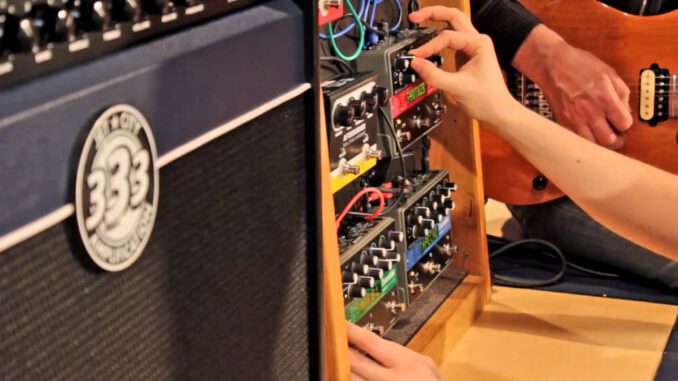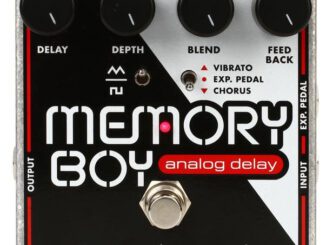
Eventide is widely known for its professional-level studio gear, most of which comes in the large format of heavy-duty rackmountable units designed to sit in studio control rooms or big stage rigs. A veritable Who’s Who of rock guitarists have incorporated Eventide’s high-end gear into their signature sound, including Jimmy Page, Frank Zappa, Robert Fripp, Brian May, Adrian Belew, Eddie Van Halen, Steve Vai, and John Petrucci.
But recently Eventide brought their state-of-the-art processing technology down to the smaller format known affectionately by guitarists as “stompboxes.” Eventide’s trio of foot-operated processors—the TimeFactor, PitchFactor, and ModFactor—offer guitarists and other electronic musicians the best of both worlds: studio-level sound quality and programming power combined with roadworthy ruggedness and portability.
Overview
The three pedals share certain features, which makes it easy to switch among the effects once you have learned one. All are housed in heavy (just over 2 pounds), solid, metal case about the size of a thick paperback book. All feature the same layout scheme with respect to number of knobs (11), display technology (a very readable Billboard approach, along with status LEDs), and multifunction footswitches (3). Eventide now offers an editor/librarian for all the Factors, as well as preset-naming and output level control. Let’s look at the individual effects.
Time passages
The TimeFactor serves up two independent delays with up to 3,000ms of delay time each in a single box. It has three modes of stereo operation along with three bypass modes. Like all Factors, it’s fully MIDI controllable, and the two pedal inputs offer greater realtime control over a multitude of parameters, virtually all of which can be mapped to either or both pedals. Its 10 effect algorithms are based on Eventide’s higher-end studio-quality processors, and include DigitalDelay, VintageDelay, TapeEcho, ModDelay, Ducked-Delay, BandDelay, FilterPong, MultiTap, Reverse, and Looper (up to 48 seconds and in three resolutions).
The TimeFactor performs any delay function beautifully: the processed audio is crystal clear and of the highest sonic integrity. The vintage tap emulations are among my favorites, especially coming from a digitally based unit that also performs the clean, high-resolution delay so well. Even the straightforward MultiTap delay offers surprises in its subtlety and richness. Using the BandDelay (which employs a low-, band-, or high-pass filter), I dialed up some pretty envelope-pushing sounds and still found a musical smoothness all the way to the settings’ extremes. And for those wacky-but-musical effects, Reverse shows off the unit’s more experimental side, yet still yields a strikingly realistic backward-in-time effect.
Pitch perfect
The PitchFactor can be used for all sorts of applications, from creating subtle detuned textures to harmonized parts against your original notes to bizarre sound effects that are right at home in electronic scores and film soundtracks. The 10 signature pitch effects are Diatonic (also called “smart” harmony, because it plays within a scale or mode), PitchFlex, Quadravox, Octaver, HarModulator, Crystals, MicroPitch, HarPeggiator, H910/H949 (evoking the classic Eventide sounds of the original Harmonizers from the 1970s), and Synthonizer. Up to four voices of diatonic pitch shifting are available for full-sounding classical and jazz harmonies, with each voice capable of 1,500ms of delay time. The resolution of the processed sound is outstanding, and if you’ve never before experimented with an arpeggiator, the PitchFactor’s HarPeggiator and HarModulator will provide limitless inspiration.
Mod art
The Eventide ModFactor features 10 modulation effects available in mono or stereo: Phaser, Flanger, Chorus, Polymod, TremoloPan, Undulator (a dual-delay with frequency-modulated tremolo), Vibrato, Q-Wah (a peak-resonant autowah), ModFilter (an envolving filter), and RingMod. These 10 basic effects include multiple types under a type knob which yields a total of 39 effect types, representing the best of Eventide’s signature modulation effects from their rack gear throughout their history.
Working with ModFactor is intuitive and quick. You can set up any two of the 100 onboard presets to be footswitchable, so that with a program dialed in, the row of knobs adjust the program’s primary parameters while the bottom four knobs adjust the LFOs. I set up a mild, subtle chorus on switch A that gave just a hint of movement. I used this for the verses. When the song went to a half-time feel in the bridge, I kicked in the B sound—a deeper, more-swirling and lush chorus that still had its DNA in my A sound. If you want to progress between these two states continuously, you would map the appropriate parameters to your external expression pedal—and then use the B switch for something else again! It’s this kind of complexity and power that make the ModFactor such a joy to work with.
Conclusion
This trio represents a complete complement of signal processors in their own right, with the additional high-end functionality of mixer compatibility and independent I/O. The TimeFactor, PitchFactor, and ModFactor also contain a wealth of other top-shelf features that put them in the class of studio processors—such as multiple bypass modes (including true, hardwire bypass). But it’s really about having that Eventide sound in a portable and modular format. All three Factors offer the rich, deep, and complex sound that Eventide is famous for, and give you insight into just how far a portable signal processor can go in helping you create and finish your computer sound.
Source: Musician’s Friend
Jon Chappell




Be the first to comment